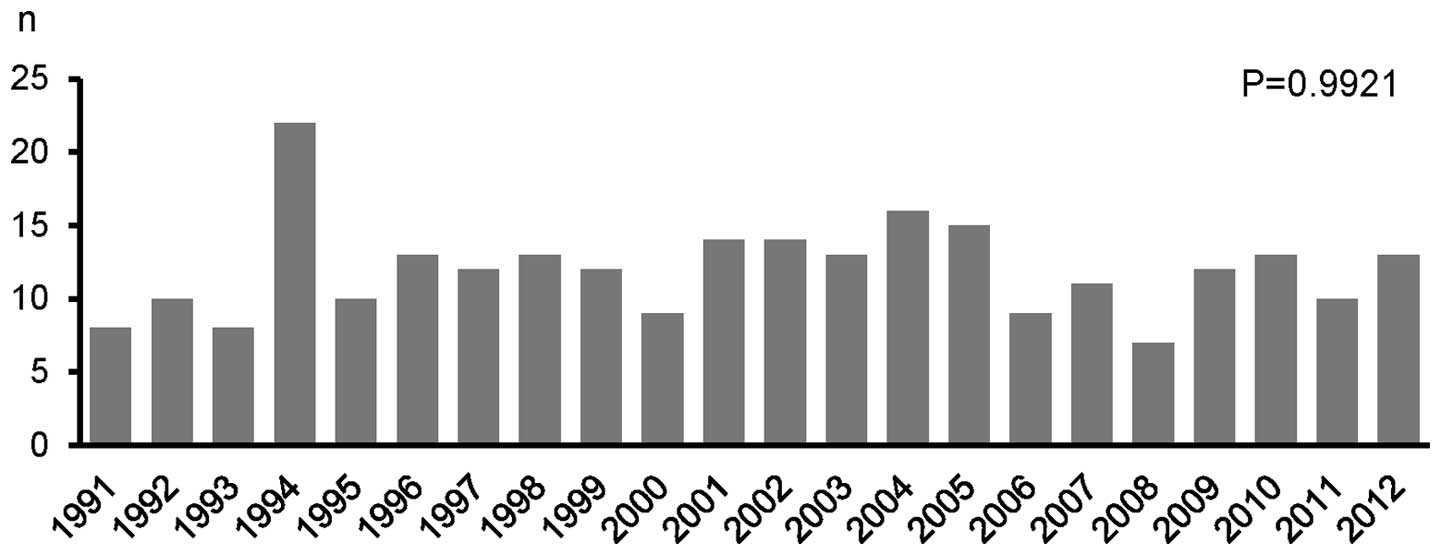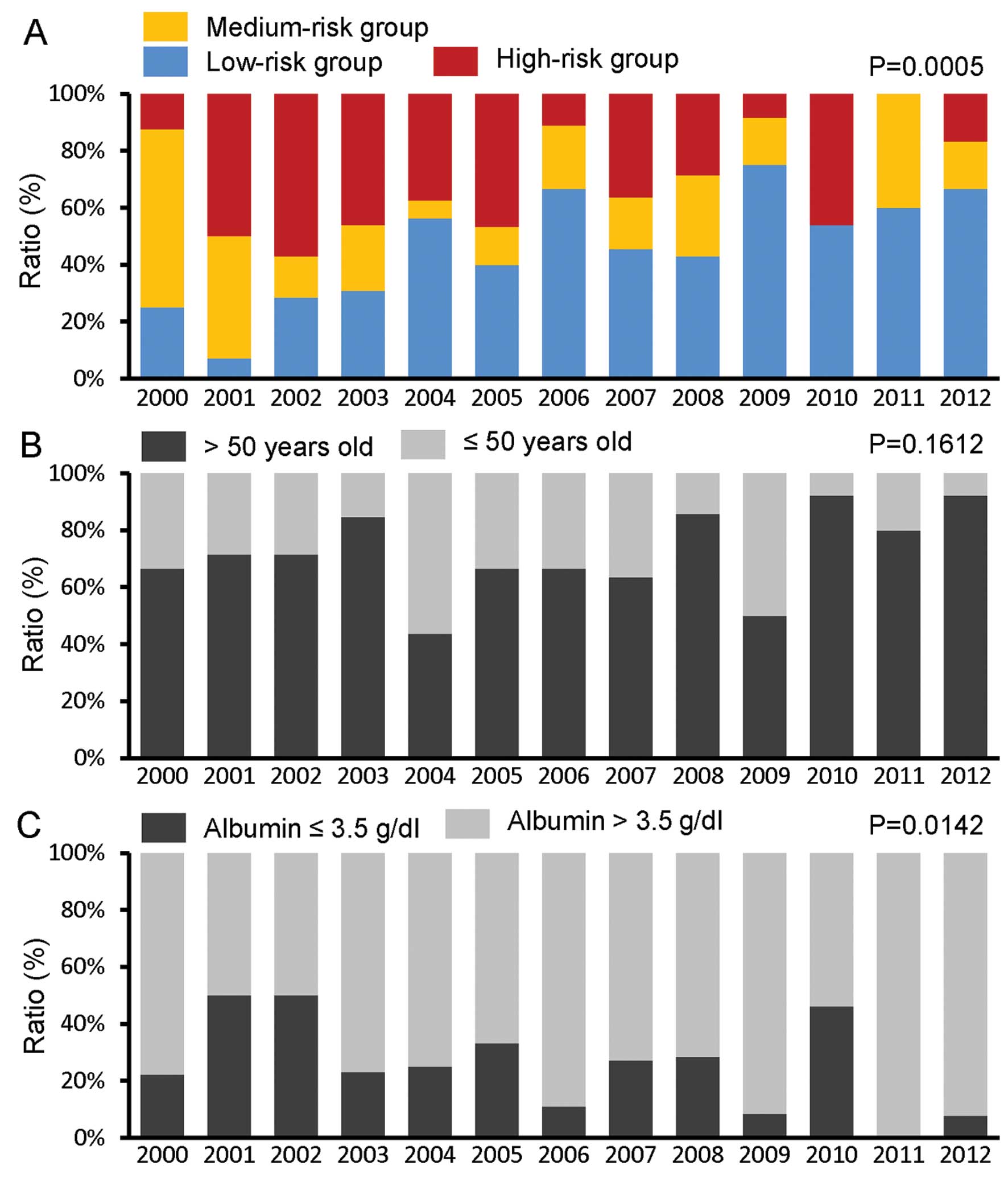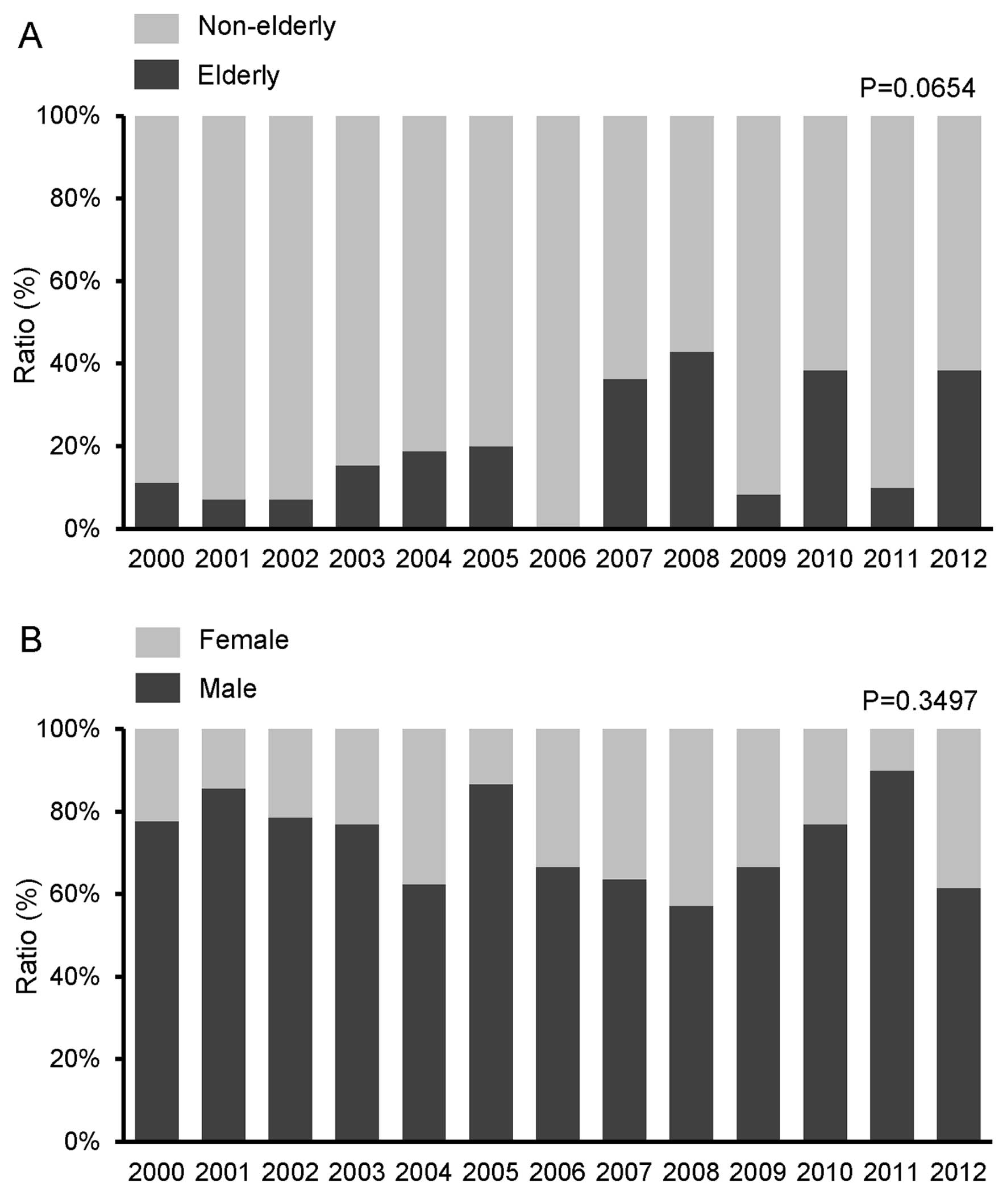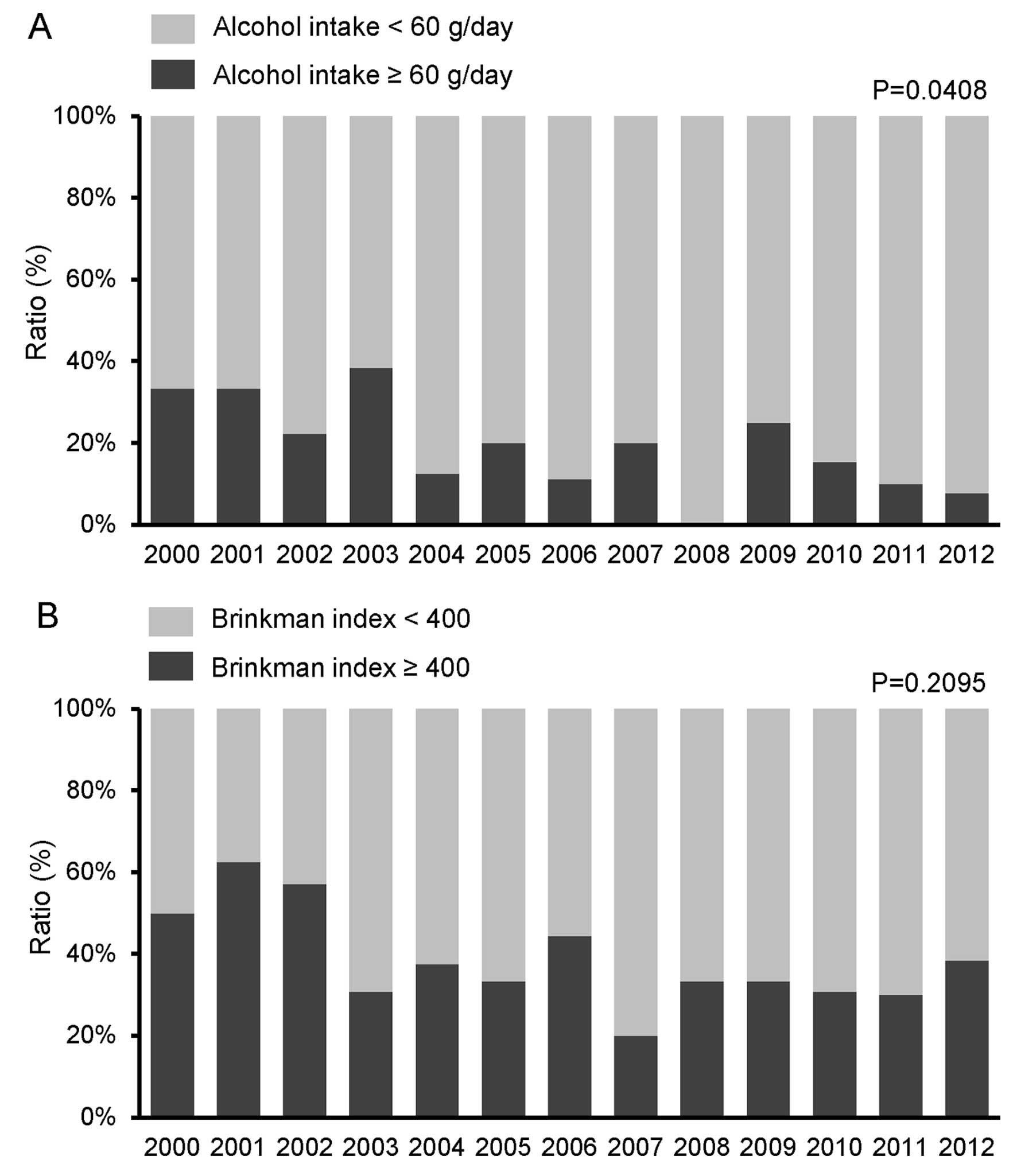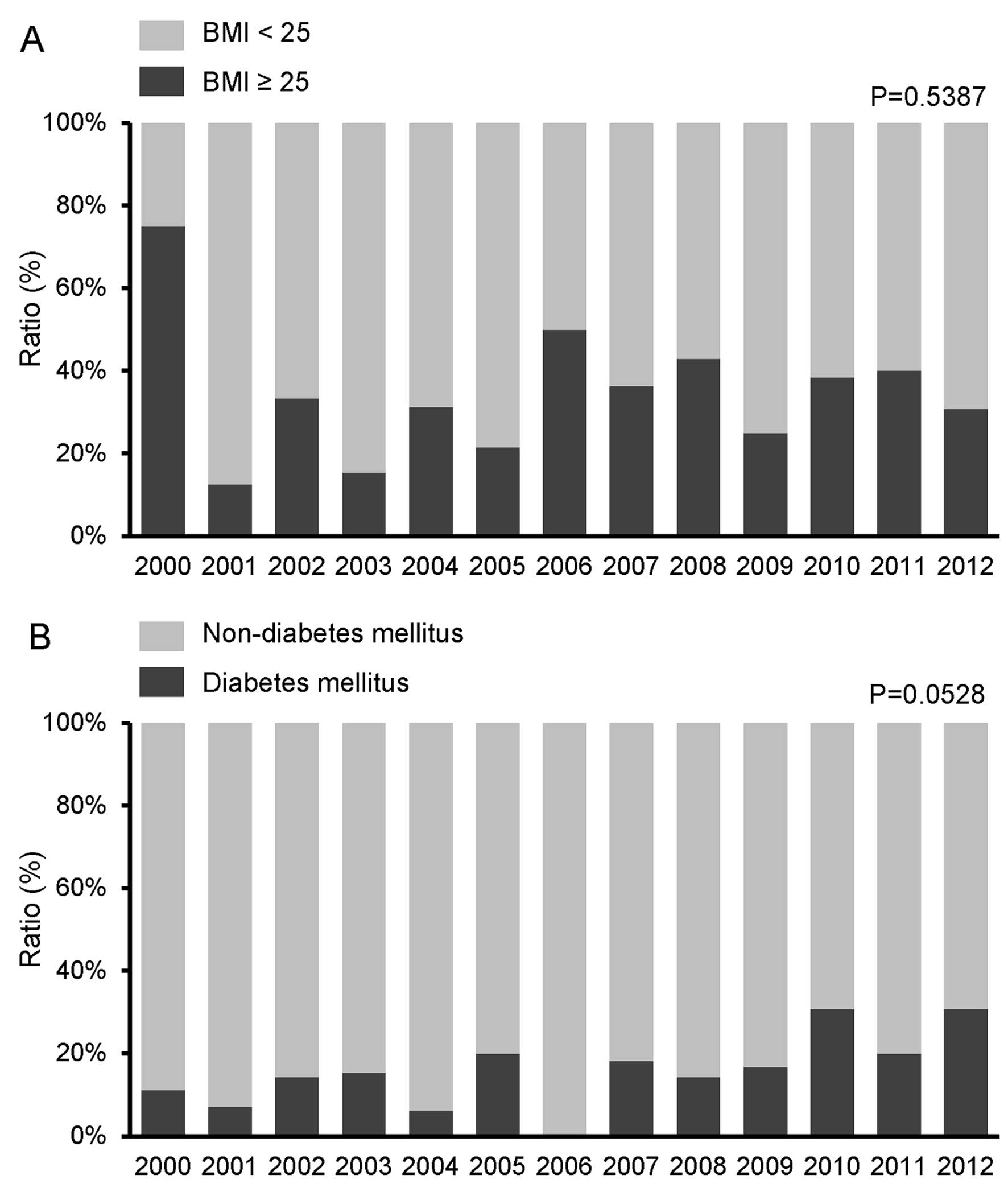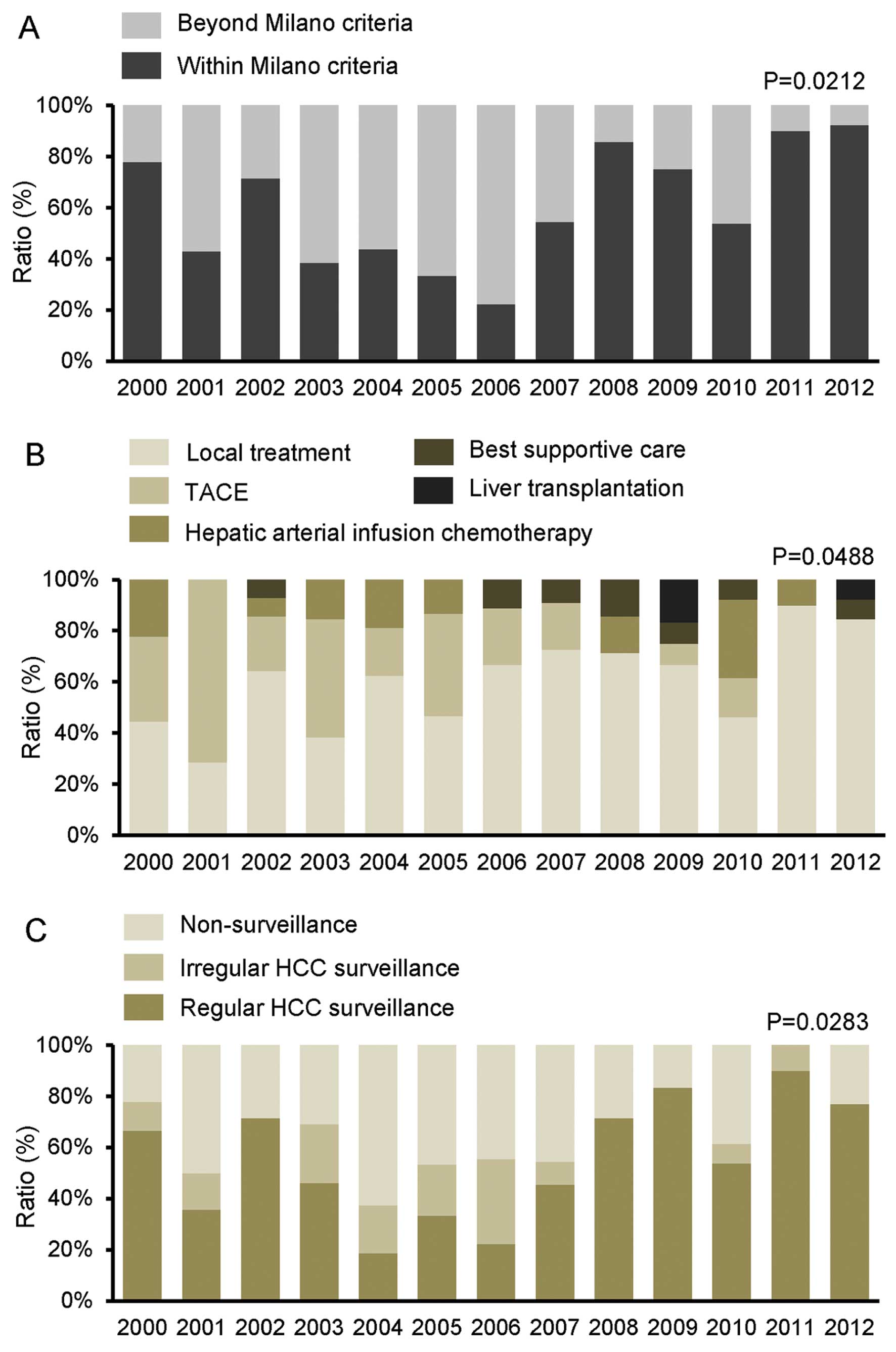|
1
|
El-Serag HB: Epidemiology of viral
hepatitis and hepatocellular carcinoma. Gastroenterology.
142:1264–1273. e12612012. View Article : Google Scholar : PubMed/NCBI
|
|
2
|
Yoshikawa A, Suzuki K, Abe A, et al:
Effect of selective vaccination on a decrease in the rate of
hepatitis B virus-positive Japanese first-time blood donors.
Transfus Med. 19:172–179. 2009. View Article : Google Scholar : PubMed/NCBI
|
|
3
|
Hosaka T, Suzuki F, Kobayashi M, et al:
Long-term entecavir treatment reduces hepatocellular carcinoma
incidence in patients with hepatitis B virus infection. Hepatology.
58:98–107. 2013. View Article : Google Scholar : PubMed/NCBI
|
|
4
|
Matsumoto A, Tanaka E, Rokuhara A, et al;
Inuyama Hepatitis Study Group. Efficacy of lamivudine for
preventing hepatocellular carcinoma in chronic hepatitis B: A
multicenter retrospective study of 2795 patients. Hepatol Res.
32:173–184. 2005. View Article : Google Scholar : PubMed/NCBI
|
|
5
|
Taura N, Fukushima N, Yastuhashi H, et al:
The incidence of hepatocellular carcinoma associated with hepatitis
C infection decreased in Kyushu area. Med Sci Monit. 17:PH7–PH11.
2011. View Article : Google Scholar : PubMed/NCBI
|
|
6
|
McMahon BJ: The natural history of chronic
hepatitis B virus infection. Hepatology. 49(Suppl 5): S45–S55.
2009. View Article : Google Scholar : PubMed/NCBI
|
|
7
|
Chen CJ, Yang HI, Su J, et al; REVEAL-HBV
Study Group. Risk of hepatocellular carcinoma across a biological
gradient of serum hepatitis B virus DNA level. JAMA. 295:65–73.
2006. View Article : Google Scholar : PubMed/NCBI
|
|
8
|
Kao JH, Chen PJ, Lai MY and Chen DS:
Hepatitis B genotypes correlate with clinical outcomes in patients
with chronic hepatitis B. Gastroenterology. 118:554–559. 2000.
View Article : Google Scholar : PubMed/NCBI
|
|
9
|
Wong VW, Chan SL, Mo F, et al: Clinical
scoring system to predict hepatocellular carcinoma in chronic
hepatitis B carriers. J Clin Oncol. 28:1660–1665. 2010. View Article : Google Scholar : PubMed/NCBI
|
|
10
|
Wong GL and Wong VW: Risk prediction of
hepatitis B virus-related hepatocellular carcinoma in the era of
antiviral therapy. World J Gastroenterol. 19:6515–6522. 2013.
View Article : Google Scholar : PubMed/NCBI
|
|
11
|
Purohit V, Rapaka R, Kwon OS and Song BJ:
Roles of alcohol and tobacco exposure in the development of
hepatocellular carcinoma. Life Sci. 92:3–9. 2013. View Article : Google Scholar : PubMed/NCBI
|
|
12
|
Farrell G: Insulin resistance, obesity and
liver cancer. Clin Gastroenterol Hepatol. 12:117–119. 2014.
View Article : Google Scholar
|
|
13
|
Kawaguchi T, Izumi N, Charlton MR and Sata
M: Branched-chain amino acids as pharmacological nutrients in
chronic liver disease. Hepatology. 54:1063–1070. 2011. View Article : Google Scholar : PubMed/NCBI
|
|
14
|
Kawaguchi T, Kakuma T, Yatsuhashi H, et
al: Data mining reveals complex interactions of risk factors and
clinical feature profiling associated with the staging of
non-hepatitis B virus/non-hepatitis C virus-related hepatocellular
carcinoma. Hepatol Res. 41:564–571. 2011. View Article : Google Scholar
|
|
15
|
Asahina Y, Tsuchiya K, Tamaki N, et al:
Effect of aging on risk for hepatocellular carcinoma in chronic
hepatitis C virus infection. Hepatology. 52:518–527. 2010.
View Article : Google Scholar : PubMed/NCBI
|
|
16
|
Yamada S, Kawaguchi A, Kawaguchi T, et al:
Serum albumin level is a notable profiling factor for non-B, non-C
hepatitis virus-related hepatocellular carcinoma: A data-mining
analysis. Hepatol Res. Jul 2–2013.(Epub ahead of print). View Article : Google Scholar
|
|
17
|
Kawaguchi T, Shiba N, Maeda T, et al:
Hybrid training of voluntary and electrical muscle contractions
reduces steatosis, insulin resistance, and IL-6 levels in patients
with NAFLD: a pilot study. J Gastroenterol. 46:746–757. 2011.
View Article : Google Scholar
|
|
18
|
Kudo M, Izumi N, Kokudo N, et al; HCC
Expert Panel of Japan Society of Hepatology. Management of
hepatocellular carcinoma in Japan: Consensus-Based Clinical
Practice Guidelines proposed by the Japan Society of Hepatology
(JSH) 2010 updated version. Dig Dis. 29:339–364. 2011. View Article : Google Scholar
|
|
19
|
Kawaguchi T, Ide T, Taniguchi E, et al:
Clearance of HCV improves insulin resistance, beta-cell function,
and hepatic expression of insulin receptor substrate 1 and 2. Am J
Gastroenterol. 102:570–576. 2007. View Article : Google Scholar : PubMed/NCBI
|
|
20
|
Wai CT, Greenson JK, Fontana RJ, et al: A
simple noninvasive index can predict both significant fibrosis and
cirrhosis in patients with chronic hepatitis C. Hepatology.
38:518–526. 2003. View Article : Google Scholar : PubMed/NCBI
|
|
21
|
Seino Y, Nanjo K, Tajima N, et al: Report
of the Committee on the classification and diagnostic criteria of
diabetes mellitus. Diabetol Int. 1:2–20. 2010. View Article : Google Scholar : PubMed/NCBI
|
|
22
|
Nakajima T, Nakashima T, Yamaoka J, et al:
Greater age and hepatocellular aging are independent risk factors
for hepatocellular carcinoma arising from non-B non-C non-alcoholic
chronic liver disease. Pathol Int. 61:572–576. 2011. View Article : Google Scholar : PubMed/NCBI
|
|
23
|
Plentz RR, Schlegelberger B, Flemming P,
et al: Telomere shortening correlates with increasing aneuploidy of
chromosome 8 in human hepatocellular carcinoma. Hepatology.
42:522–526. 2005. View Article : Google Scholar : PubMed/NCBI
|
|
24
|
Plentz RR, Park YN, Lechel A, et al:
Telomere shortening and inactivation of cell cycle checkpoints
characterize human hepatocarcinogenesis. Hepatology. 45:968–976.
2007. View Article : Google Scholar : PubMed/NCBI
|
|
25
|
Wang Y, Cheng J, Xu C, et al: Quantitative
methylation analysis reveals gender and age differences in p16INK4a
hypermethylation in hepatitis B virus-related hepatocellular
carcinoma. Liver Int. 32:420–428. 2012.PubMed/NCBI
|
|
26
|
Chen CT, Chen JY, Wang JH, et al: Diabetes
mellitus, metabolic syndrome and obesity are not significant risk
factors for hepatocellular carcinoma in an HBV- and HCV-endemic
area of Southern Taiwan. Kaohsiung J Med Sci. 29:451–459. 2013.
View Article : Google Scholar : PubMed/NCBI
|
|
27
|
Gao C, Zhao HC, Li JT and Yao SK: Diabetes
mellitus and hepatocellular carcinoma: comparison of Chinese
patients with and without HBV-related cirrhosis. World J
Gastroenterol. 16:4467–4475. 2010. View Article : Google Scholar : PubMed/NCBI
|
|
28
|
Chen CL, Yang HI, Yang WS, et al:
Metabolic factors and risk of hepatocellular carcinoma by chronic
hepatitis B/C infection: a follow-up study in Taiwan.
Gastroenterology. 135:111–121. 2008. View Article : Google Scholar : PubMed/NCBI
|
|
29
|
Hotta N, Nakamura J, Iwamoto Y, Ohno Y,
Kasuga M, Kikkawa R and Toyota T: Causes of death in Japanese
diabetics: A questionnaire survey of 18,385 diabetics over a
10-year period. J Diabetes Investig. 1:66–76. 2010.PubMed/NCBI
|
|
30
|
Eslam M, Aparcero R, Kawaguchi T, Del
Campo JA, Sata M, Khattab MA and Romero-Gomez M: Meta-analysis:
insulin resistance and sustained virological response in hepatitis
C. Aliment Pharmacol Ther. 34:297–305. 2011. View Article : Google Scholar : PubMed/NCBI
|
|
31
|
Kawaguchi T, Yoshida T, Harada M, et al:
Hepatitis C virus down-regulates insulin receptor substrates 1 and
2 through up-regulation of suppressor of cytokine signaling 3. Am J
Pathol. 165:1499–1508. 2004. View Article : Google Scholar : PubMed/NCBI
|
|
32
|
Calle EE and Kaaks R: Overweight, obesity
and cancer: epidemiological evidence and proposed mechanisms. Nat
Rev Cancer. 4:579–591. 2004. View Article : Google Scholar : PubMed/NCBI
|
|
33
|
Kobayashi M, Hosaka T, Ikeda K, et al:
Highly sensitive AFP-L3% assay is useful for predicting recurrence
of hepatocellular carcinoma after curative treatment pre- and
postoperatively. Hepatol Res. 41:1036–1045. 2011.
|
|
34
|
Inoue T, Kudo M, Komuta M, et al:
Assessment of Gd-EOB-DTPA-enhanced MRI for HCC and dysplastic
nodules and comparison of detection sensitivity versus MDCT. J
Gastroenterol. 47:1036–1047. 2012. View Article : Google Scholar : PubMed/NCBI
|
|
35
|
Koga H, Ide T, Oho K, et al: Lamivudine
treatment-related morphological changes of esophageal varices in
patients with liver cirrhosis. Hepatol Res. 37:503–509. 2007.
View Article : Google Scholar : PubMed/NCBI
|
|
36
|
Chang TT, Liaw YF, Wu SS, et al: Long-term
entecavir therapy results in the reversal of fibrosis/cirrhosis and
continued histological improvement in patients with chronic
hepatitis B. Hepatology. 52:886–893. 2010. View Article : Google Scholar
|
|
37
|
Tateishi R, Shiina S, Teratani T, et al:
Percutaneous radiofrequency ablation for hepatocellular carcinoma.
An analysis of 1000 cases. Cancer. 103:1201–1209. 2005.PubMed/NCBI
|
|
38
|
Ando E, Kuromatsu R, Tanaka M, et al:
Surveillance program for early detection of hepatocellular
carcinoma in Japan: results of specialized department of liver
disease. J Clin Gastroenterol. 40:942–948. 2006. View Article : Google Scholar : PubMed/NCBI
|
|
39
|
Nakano M, Ando E, Kuromatsu R, et al:
Recent progress in the management of hepatocellular carcinoma
detected during a surveillance program in Japan. Hepatol Res.
40:989–996. 2010. View Article : Google Scholar
|















